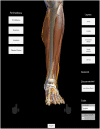Development of a Virtual Three-Dimensional Assessment Scenario for Anatomical Education
- PMID: 33465814
- PMCID: PMC8252734
- DOI: 10.1002/ase.2055
Development of a Virtual Three-Dimensional Assessment Scenario for Anatomical Education
Abstract
In anatomical education three-dimensional (3D) visualization technology allows for active and stereoscopic exploration of anatomy and can easily be adopted into medical curricula along with traditional 3D teaching methods. However, most often knowledge is still assessed with two-dimensional (2D) paper-and-pencil tests. To address the growing misalignment between learning and assessment, this viewpoint commentary highlights the development of a virtual 3D assessment scenario and perspectives from students and teachers on the use of this assessment tool: a 10-minute session of anatomical knowledge assessment with real-time interaction between assessor and examinee, both wearing a HoloLens and sharing the same stereoscopic 3D augmented reality model. Additionally, recommendations for future directions, including implementation, validation, logistic challenges, and cost-effectiveness, are provided. Continued collaboration between developers, researchers, teachers, and students is critical to advancing these processes.
Keywords: augmented reality; formative assessment; gross anatomy education; stereoscopic three-dimensional visualization technology; summative assessment; undergraduate education; virtual reality.
© 2021 The Authors. Anatomical Sciences Education published by Wiley Periodicals LLC on behalf of American Association for Anatomy.
Figures




References
-
- Al‐Kadri HM, Al‐moamary MS, Roberts C, van der Vleuten CP. 2012. Exploring assessment factors contributing to students' study strategies: Literature review. Med Teach 34:42–50. - PubMed
-
- Anderson T, Shattuck J. 2012. Design‐based research: A decade of progress in education research? Educ Res 41:16–25.
-
- Azer SA, Eizenberg N. 2007. Do we need dissection in an integrated problem‐based learning medical course? Perceptions of first‐ and second‐year students. Surg Radiol Anat 29:173–180. - PubMed
-
- Bergman EM, Prince KJ, Drukker J, van der Vleuten CP, Scherpbier AJ. 2008. How much anatomy is enough? Anat Sci Educ 1:184–188. - PubMed
MeSH terms
LinkOut - more resources
Full Text Sources
Other Literature Sources
Medical

